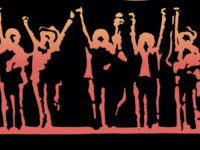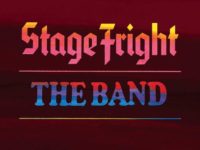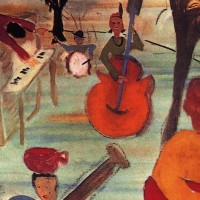The introduction of a new studio to experiment with might have felt like a happy challenge for another Band, in another place. Instead, Albert Grossman’s just-opened Bearsville facility ended up feeling, as Robbie Robertson once said, “too bright and cold.”
To be honest, much of the music from the subsequent Cahoots (released on September 15, 1971) did too — with some notable exceptions, among them this oaken, deeply emotional reading of a Bob Dylan classic …
‘WHEN I PAINT MY MASTERPIECE’: Its theme couldn’t have been more appropriate, both for Cahoots and, sadly, for the Band itself. Bob Dylan, who had first recorded “When I Paint My Masterpiece” in mid-March of 1971 with Leon Russell, seems to be admitting — and not even tacitly — that his muse had left him during the period surrounding New Morning.
Of course, a lyric intent on reconstructing Rome, after it had been left to dilapidation and despair, seems indicative of someone still pushing back against this creative ennui. And yet, as we hear on Levon Helm’s mournful vocal, even a change of scenery in Brussels is shadowed with thoughts of what came before.
Typically opaque, and very darkly poignant, “When I Paint My Masterpiece” sounds like something the Band would have done with Dylan during the Basement Tapes sessions, an era that must have seemed like a very long time ago at this point for both.
The worry, as evidenced both in Dylan narrative’s and on an eerie cover image which finds the Band standing in front of what looks like a mausoleum, was that Rome might never be rebuilt — that their best days, memorable though they may be, were behind them.
Thankfully, Cahoots, though still determinedly overlooked, made a few more notable arguments for their continued relevancy.
‘4% PANTOMIME’: On an album that so often feels overcooked and too careful, the sloshy, gospel-gone-wrong of “4% Pantomime” lets it all hang down. That kind of loose camaraderie from the Band, so natural at first but by this point becoming an ever-more-rare occasion, could be sorely missing elsewhere on 1971’s Cahoots.
Recorded on a whim when Van Morrison stopped by the Bearsville Studios as the Band was agonizing its way through a fourth album, “4% Pantomime” would capture an increasingly precious moment of unbridled joy in the studio for singer Richard Manuel, who had become fast friends with Morrison in the period when the emerging Irish talent was recording Moondance. The feeling was clearly contagious. A conversation between the two about the difference in alcoholic content between Johnny Walker’s Red and Black label whiskey (thus, the song’s title) apparently devolved into a series of drinks, and then an impromptu session that ultimately completed a Robbie Robertson song fragment.
As they tell the story of two like-minded musos stuck in Los Angeles with only a brown bottle, Richard Manuel and Morrison famously acted out the parts, bringing this one-take song’s narrative to life even as the rest of the Band played happily along. Maybe it should have never made the final track listing for Cahoots, but “4% Pantomime” certainly lightened things up. “It was almost like this movement thing was going on,” Robertson once said, “and the music was carrying itself. It’s bizarre and wild. It was a lot of fun to do it. It was an archive kind of thing that we actually put on record.”
Manuel takes the first verse, painting a portrait of boozy vicissitudes over his own brilliantly syncopated cadence, before Morrison comes barreling in — baying at the moon with a happy disregard for the neighbors. “4% Pantomime” continues swaying back and forth, punctuated by the thunderous funk of Rick Danko’s bass and an entirely appropriate slur from Garth Hudson’s keyboard, even as Manuel and Morrison lock arms for a pew-splintering run toward the song’s end.
See, the churchy undertones inherent in this anthemic finale are violently run down by a confetti-spewing carnival of decadent revelry. A delirious Richard Manuel howls out Robbie Robertson’s new nickname for Morrison (the “Belfast Cowboy”), before Robertson’s guitar pushes the song ever onward via a tornadic riff. By the end of “4% Pantomime,” this session sounds like a barely controlled party that threatened to spill out of the studio at any second.
“It was an extremely liquid session,” Levon Helm recalled in This Wheel’s On Fire. “Van and Richard were into it, and there was horror among the civilians at the studio when the two dead-drunk musicians argued about who would drive the other one home. Richard drove, and I think he made it. Lord knows he wrecked a lot of cars that year.”
Unfortunately, it seems like the bad times were beginning to overtake the good at an alarming rate for Manuel. There wouldn’t be nearly enough of these moments over the last years of this unhappy soul’s life.
‘THINKING OUT LOUD’: As Rick Danko gives voice to the larger worries that dominated Cahoots — the heroes were, of course, all gone — it becomes utterly clear just what writer Robbie Robertson is lamenting.
A surface reading of this flawed project would have you to believe that he’s talking about a disappearing America. Instead, listen as Robertson piles of these devastating images of decay, of finality and goodbyes. They are, in particular within Danko’s trembling emotionality, as striking and as specific on “Thinking Out Loud” as anywhere on Cahoots: The monkey on his back, the knowing that it would not last, the crashing sky, the coming fully awake only after a sudden fall to the ground — all of it puts every bad vibe associated with this period into perspective. By the early-1970s, post-Brown Album era, Robertson was losing — maybe had already lost — the Band.
And there’s nothing musically that the attendant musicians here can do, despite game turns of barrelhouse gumption by both Garth Hudson and Robertson himself, to lift the Robertson lyric’s heavy feeling of absence. That missing thing, it’s always seemed to me, was the Band itself — or, at the very least, our idea of it as a musicmaking brotherhood, as a communal voice. They’d become impossibly famous on the power of that imagery. But by the time they set about trying to make Cahoots, it seemed to be irretrievably gone.
“I think we shipped a million copies of that second album,” Danko once told me, “and that changed a lot of people’s lives — in particular, the Band’s. After that, we were only getting together once a year, for a couple of months, to record. It was like we were too decadent to play.”
Cahoots is so reflective of those sentiments that it feels, it’s always felt, like a breakup album. The Band is suddenly reaching backward, suddenly reaching for everything, and nostalgia — as their frequent collaborator Bob Dylan once said — is death.
“It was hard for me to pull the whole thing together,” Robertson says, in the attached video. “It was hard for me during Cahoots, and it started before that, even. But during Cahoots, if everybody would show up, it was still like not everybody was there. There was a whole feeling of pulling teeth. Everything was hard, and it was painful trying to do things, and there’d be just no sense of it going anywhere. So it was hard for me to write, under those circumstances. It was hard for us to get together and make music.”
Where the blame lies for these widening fissures remains the topic of spirited, often emotional debate. What the music tells us, however, is something deeper than culpability, something sadder. The Band sounded like they were finished.
The more Rick Danko thought about this period, in our long-ago talk, the more ruminative he became. “The drugs, the decadence, the alcohol,” he said, trailing off. Still, he wasn’t one to focus on the sometimes withering criticism that surrounded the Band in this period. “I remember when people started comparing Johnny Cash to Johnny Cash,” Danko said. “You just kind of do what you do. It’s as desperate as that, or not as desperate.” He stopped short then, chuckling. “Like Janis Joplin used to tell me: It’s hard to sing the blues when you’re a millionaire.”
We now know that the Band would eventually issue another album of original material — but that it would take more than four years, an eternity back then. In retrospect, the idea of them ever getting to 1975’s Northern Lights-Southern Cross, after the unfocused disappointments of Cahoots, is its own kind of miracle. Somehow, however, they did. And the results there would amount to one of the Band’s often-forgotten treasures, a final flourish before everything actually blew apart for the five-man edition.
‘THE RIVER HYMN’: One of Levon Helm’s loveliest, most fervent vocals is tucked away at the end of an often-overlooked, often over-thought album, as “The River Hymn” brings the Band’s darkly ruminative Cahoots to a churchy close. Maybe Cahoots — and this song itself — couldn’t quite grasp everything it was reaching for. But “The River Hymn” still shows what a performance, stripped of artifice and centered on a generations-old sense of place, can do to bridge that gap.
As a symbol, the endless river stood in stark contrast to the carnival-like atmosphere that dominated this album’s beginning. Much of what came in between had posed deeper questions about modern times, with outwardly nostalgic titles like “Last of the Blacksmiths,” “Where Do We Go From Here?” and “Smoke Signal.” Looking back, that could be seen as a metaphor for the fracturing of the Band itself, as much as a probing inquiry into the loss of tradition.
But what of this track, this final, overstuffed burst of faith-filled light? “The River Hymn” seemed like a passage way to something else, though we know not what. Perhaps, it’s a promise for salvation, if not for the Band itself then for the rest of us. Whatever it’s deeper import, the Band ultimately crafted one of their shared discography’s most spiritually uplifting moments, almost as if they are singing in the spirit — though its busy arrangement tries to obscures these wonders.
Pay close attention to Garth Hudson, who offers a gospel-tinged opening statement before a switch to the Lowrey adds these plumes of ruminative color. Later, Robbie Robertson’s saloon-keeper’s piano is perfectly matched to Richard Manuel’s loping rhythm. That’s the equal and opposite, in terms of texture, of the choir-like vocal contributions of Libby Titus. Then Helm’s partner, she joins in a few heavenly asides with Rick Danko and Richard Manuel, a distracting choice at first — but one that later begins to make more narrative sense.
After all, Helm’s stirring, utterly ardent approach with Robertson’s lyric ultimately sounds as ecclesiastical as anything the Band ever did, irrespective of the musical maelstrom all around. Listen as Helm’s voice cracks, on the final iteration of the word “son.” You can almost feel the baptismal waters running away from your face in rivulets.
Along the way, “The River Hymn” seems to answer the questions that Cahoots has raised, about the manner in which folkways can continue forward into modern times, about the way faith can sustain us, about the comfort and foundation of music. Those are big ideas, and Robbie Robertson tries to match them with a suitably episodic, almost cinematic palette.
Perhaps expectedly, “The River Hymn” fell flat with fans of the Band’s more typically straight-forward, roots-bound approach. As with many overly ambitious moments, I suppose it could be seen as a noble failure. That is, if it wasn’t so completely, heart-openingly beautiful.
- How Deep Cuts on ‘Music From Big Pink’ Underscore the Band’s Triumph - July 31, 2023
- How ‘Islands’ Signaled the Sad End of the Band’s Five-Man Edition - March 15, 2022
- The Band’s ‘Christmas Must Be Tonight’ Remains an Unjustly Overlooked Holiday Classic - December 25, 2016




